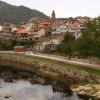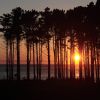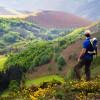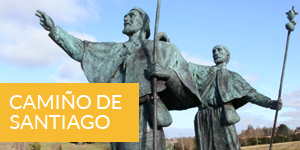- Accede I
- Regístrate I
- carrito
Ourense y O Ribeiro: Villas Medievales entre viñedos
Duración: 1 día completo
Itinerario: Ourense - Ribadavia - San Clodio
Descripción: Ourense ya tuvo importancia en época romana, de la que datan los basamentos de su puente. Destaca su Catedral -s. XII y posteriores-, y las iglesias, calles, plazas y jardines de su cuidado casco histórico, en el que se respira el buen vivir de una tranquila ciudad de provincias. Es además la ciudad de las “Burgas”: tres fuentes cuyas temperaturas rondan los 70ºC, cuya existencia ha dado lugar a muchas teorías y explica la importancia del termalismo en la zona. En sus proximidades está la comarca de O Ribeiro, una de las más interesantes de la Galicia interior. El paso de los siglos ha dejado aquí una gran riqueza monumental: pueblos medievales, monasterios, iglesias y pazos salpican esta tierra de relieve suave, suelo fértil, y clima privilegiado, que produce el vino Ribeiro, cuya calidad ya reconocían los romanos. Su núcleo más importante es Ribadavia: declarado Conjunto Histórico-Artístico en 1947, es una joya de la Edad Media que conserva importante barrio judío.
Paradas recomendadas
Ourense-Ribadavia
El itinerario empieza en la ciudad de Ourense, vecina de la comarca de O Ribeiro.
La comarca de O Ribeiro, situada en torno al curso medio del río Miño, al oeste de la provincia de Ourense y limítrofe con la de Pontevedra, tiene un variado repertorio de atractivos culturales, paisajísticos y gastronómicos que hacen de esta zona una de las más interesantes de la Galicia interior. Su localidad más importante es Ribadavia.
El agua, la de sus ríos, la de sus balnearios y la de sus embalses, juega un papel fundamental en la personalidad de la zona. A su paso por estas tierras, los ríos Miño, Arnoia y Avia dan lugar a sucesivos remansos y gargantas, produciendo de esta manera el paisaje emblemático de O Ribeiro. En los valles fluviales se asienta la mayor parte de la población de la comarca. El relieve es suave, de formas redondeadas, el suelo fértil, y el clima benigno.
Los bosques frondosos acompañan los cauces de los ríos. Entre todos los cultivos, frecuentemente dispuestos en vistosos bancales o 'socalcos', destaca la vid. Las diversas variedades de la Denominación de Origen 'Ribeiro', han proporcionado a los vinos de estas tierras una reputación de calidad ya reconocida en tiempos del Imperio Romano.
El paso de los siglos ha dejado una gran riqueza monumental en forma de pueblos medievales, monasterios, iglesias, conventos y puentes y, aunque no existen grandes alturas, la zona cuenta con varios miradores que se abren a los paisajes de viñedos y huertas tan característicos de esta región.
Ourense
Ciudad ribereña a orillas del Miño, es la capital de la única provincia gallega que no tiene mar. Tuvo importancia ya en época romana por ser un lugar idóneo para cruzar el Miño. De entonces datan los basamentos de su Puente Viejo, que sigue siendo referencia esencial de la ciudad.
Destaca además por su catedral (s.XII y posteriores), y especialmente el Pórtico del Paraíso, emulación del Pórtico de la Gloria de Santiago de Compostela. Y por las iglesias de San Francisco -gótica-, de la Trinidad, de Santa Eufemia y de Santa María la Madre. Y, por supuesto, también por las calles, plazas y jardines de su cuidado casco histórico, en el que se respira el ritmo tranquilo y el buen vivir de una vieja ciudad de provincias.
Ourense es además la ciudad de las 'Burgas': tres fuentes termales, con temperaturas que rondan los 70ºC, cuyo origen ha dado lugar a muchas teorías.
Ribadavia
Esta localidad, capital de O Ribeiro, ocupa la confluencia de los ríos Avia y Miño, en el camino entre Ourense y Vigo. El paisaje que la rodea es de valles fluviales, viñedos y suaves colinas.
En el XII comienza su período de expansión comercial y demográfica, aprovechando la pujanza de los monasterios cercanos de San Clodio y Melón. A partir de ahí, Ribadavia albergó a una numerosa comunidad judía, que participaba del próspero negocio vinícola y cuya influencia es todavía patente.
Su vida económica, muy próspera entre los siglos XV y XVII, ha estado siempre ligada al vino. Sus caldos son reconocidos en Europa desde la Antigüedad y exportados al Nuevo Mundo tras el Descubrimiento.
Tantos siglos de vida han dejado en Ribadavia un legado artístico y cultural de gran riqueza, que fue merecedor de la declaración Conjunto-Histórico Artístico en el año 1947.
Entre las construcciones civiles destacan el Castillo de los Condes de Ribadavia (s. XV), en cuyo interior existen enterramientos excavados en roca viva del siglo IX y un sepulcro del siglo XII; el Barrio Judío, conjunto único en Galicia, o las murallas (s. XII-XV), que alcanzan en algunos puntos los 5,50 m de altura y conservan tres de sus cinco puertas originales, y también la Casa de la Inquisición (s. XVI), que en su época vigiló especialmente a los judíos conversos, sospechosos de herejía. El repertorio religioso lo forman la iglesia y convento de Santo Domingo, la iglesia de Santiago, la iglesia de Santa María de Oliveira, la iglesia de San Juan y la capilla de Nuestra Señora del Portal.
Además de la arquitectura, Ribadavia tiene otros muchos atractivos culturales. El 'Museo Etnolóxico', situado en un pazo (s. XVIII), posee una excelente colección y uno de los mejores fondos bibliográficos en temas históricos de Galicia. Y está también la muy concurrida 'Festa da Istoria', celebración cuyo origen se remonta al siglo XVII y que durante un día, el último sábado de agosto o el primero de septiembre, traslada a Ribadavia al Medievo: trajes de época, bailes y música, mercado, artesanía, recreación de las bodas judías..., todo es medieval, e incluso se adopta el maravedí como moneda oficial.
Es muy curioso descubrir que en Ribadavia la influencia hebrea pervive todavía: en varios establecimientos se siguen elaborando de forma artesanal dulces judíos, como el 'kamisch-broit', el 'ma´amul' o las 'masiñas de mapoulas'.























